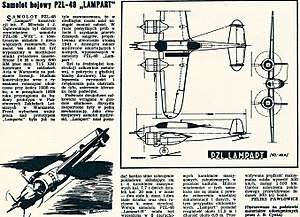PZL.48 Lampart
| PZL.48 Lampart | |
|---|---|
 | |
| Role | Fighter-bomber aircraft |
| Manufacturer | Państwowe Zakłady Lotnicze |
| Status | Project |
| Primary user | Polish Air Force (planned) |
| Number built | Incomplete prototype |
| Developed from | PZL.38 Wilk |
| Variants | PZL.54 Ryś |
The PZL.48 Lampart (leopard) was a Polish heavy fighter-bomber design, that remained only a project, owing to the outbreak of World War II.
Design and development
The PZL.48 was a development of the heavy fighter-bomber PZL.38 Wilk, designed by Franciszek Misztal. Owing to problems with PZL.38's PZL Foka V8 engines and the excessive weight of the prototype it was decided in 1938 to build a variant of the plane using more powerful radial engines, named PZL.48 Lampart. Despite the new plane appearing almost identical to the PZL.38, apart from the engines, it was, in fact, redesigned in order to decrease weight. French 640 hp Gnome-Rhône 14M engines of small diameter were chosen.
Building of a prototype started in 1939, but by summer 1939 only a wing had been made, while the fuselage was still under construction. It was planned to carry out static trials in Autumn 1939 and to fly the prototype in the first half of 1940. Further plans were to produce 110 Lamparts for the Polish Air Force in 1941. Owing to the German invasion on 1 September 1939, all plans were cancelled.
In early 1939 Misztal also worked out the initial design of the PZL.54 Ryś - a development of the PZL.48 with Hispano-Suiza 12L in-line engines.
Operators (planned)
Specification
It was a twin-engine low-wing cantilever monoplane of metal construction, metal covered. The fuselage was semi-monocoque, elliptic in cross-section. The crew of two - pilot and rear gunner/bombardier/observer - sat under separate canopies, far from each other, fitted with dual controls. The canopy of the pilot's cockpit opened sideways. Three part wing, outer parts built around light closed profiles. Wings fitted with slats and split flaps. Twin vertical stabilizers. Engines in underwing nacelles with NACA covers. Retractable landing gear, with main wheels retracting into engine nacelles, and a rear skid. Three-blade variable-pitch propellers. Integral fuel tanks in wings. Armament (planned): two fixed 20 mm guns and two 7.92 mm PWU wz.36 machine guns in the fuselage nose, twin 7.92 mm PWU wz.37 machine guns of a rear gunner, hiding in the fuselage (Lampart A) or 8 fixed machine guns (Lampart B). It could carry 300-kg of bombs.
Specifications
General characteristics
- Crew: 2, pilot, rear gunner/bombardier
- Capacity: 1,100 kg (2,425.08 lb) useful load
- Length: 8.7 m (28 ft 7 in)
- Wingspan: 11.5 m (37 ft 9 in)
- Height: 2.5 m (8 ft 2 in)
- Wing area: 21.5 m2 (231 sq ft)
- Empty weight: 2,400 kg (5,291 lb)
- Gross weight: 3,500 kg (7,716 lb)
- Powerplant: 2 × Gnome-Rhône 14M-07 14-cyl. air-cooled two-row radial engines, 540 kW (730 hp) each
Performance
- Maximum speed: 560 km/h (348 mph; 302 kn)
- Range: 1,500 km (932 mi; 810 nmi)
- Service ceiling: 10,000 m (33,000 ft)
- Rate of climb: 9 m/s (1,800 ft/min)
- Wing loading: 154 kg/m2 (32 lb/sq ft)
Armament
- 2 x 20 mm (0.787 in) Nkm wz.38 FK cannon fixed in nose
- 2 x 7.92 mm (0.312 in) PWU wz.36 machine guns fixed in nose
- 2 x 7.92 mm (0.312 in) PWU wz.37 machine guns on a flexible mounting to the rear
- 300 kg (661.39 lb) of bombs
References
- Andrzej Glass: "Polskie konstrukcje lotnicze 1893-1939" (Polish aviation constructions 1893-1939), WKiŁ, Warsaw 1977 (Polish language, no ISBN)
See also
| Wikimedia Commons has media related to PZL aircraft. |
Related development
Aircraft of comparable role, configuration and era